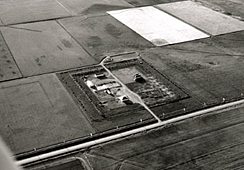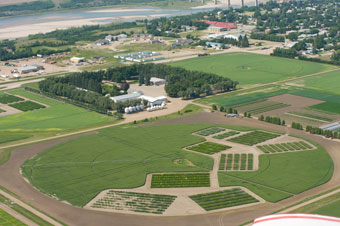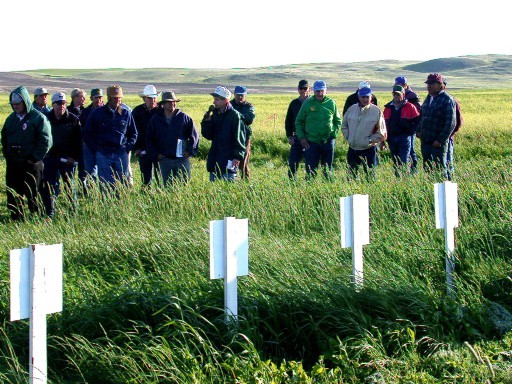
The Canada-Saskatchewan Irrigation Diversification Centre (CSIDC) promotes economically and environmentally sustainable irrigation practices to producers and industry. CSIDC investigates and demonstrates crops, technologies, and best management practices that help producers to sustain land and water resources while maintaining their economic viability.
The Centre consists of 145 hectares of federal land at Outlook, Saskatchewan, Canada comprised of 80 hectares on the main site and 65 hectares on a satellite irrigated site located east of Outlook. A total of 125 hectares is available for irrigation research and demonstration ranging from small plot trials to commercial scale production.
A major priority of the Centre is to diversify irrigated crop production options for rural clients. The benefits of higher value crops, such as dry bean and seed potato, include greater economic returns, opportunities to add value, and increased sustainability of the rural economy. Agronomic information is made available to producers who want to diversify their operations outside the scope of traditional crops.
Applied research at CSIDC also focuses on identifying practical best management practices that reduce the impacts of irrigation on the environment. Activities include monitoring the fate of agrochemicals, developing management practices for improved nutrient and water use efficiencies, understanding and mitigating agricultural greenhouse gas emissions, and improving irrigated crop production practices.
Demonstration activities focus upon improved on-farm crop management of both field and forage crops. This includes evaluating the effects of seeding rates, fertilizers, fungicide, and growth regulators on crop yield, improving management of problem soils, and increasing awareness of improved irrigation scheduling methods.
CSIDC's emphasis on technology transfer ensures that clients have access to technical and developmental opportunities through factsheets, displays, annual reports, field days, tours, and scientific publications.
CSIDC is a partnership among Agriculture and Agri-Food Canada, Saskatchewan Agriculture, the Irrigation Crop Diversification Corporation (ICDC), the Saskatchewan Irrigation Projects Association (SIPA), and the University of Saskatchewan.
About the Centre
Organizational structure
The Canada-Saskatchewan Irrigation Diversification Centre (CSIDC) is structured as a partnership between Agriculture and Agri-Food Canada (AAFC), the Saskatchewan Ministry of Agriculture, the Irrigation Crop Diversification Corporation, the Saskatchewan Irrigation Projects Association, and the University of Saskatchewan.
The partnership operates under a strategic framework agreement: the Canada-Saskatchewan-Industry Framework Agreement for Irrigation Based Economic Development and Environmental Sustainability. The agreement provides a means for the partners to collaborate in support of irrigation-based economic development and environmental sustainability.
The objectives of the Framework Agreement are:
- To create a mechanism that supports a co-ordinated approach between the parties to promote the economic and environmental goals of the partners,
- To establish a management structure and to provide resources to enable a co-operative approach to irrigation research, demonstration, education, and public awareness, and
- To provide for the collaborative use of the CSIDC's land, facilities, and equipment to conduct irrigation research, demonstration, and education activities.
Brief history

The Canada-Saskatchewan Irrigation Diversification Centre originated as the Prairie Farm Rehabilitation Administration (PFRA) Farm at Outlook, Saskatchewan. The PFRA Pre-development Farm was established in 1949 prior to the construction of the Gardiner Dam on the South Saskatchewan River. The farm was designed to demonstrate irrigation technology to assist farmers in their transition to irrigated agriculture. Upon completion of the Gardiner Dam and the formation of Lake Diefenbaker, the farm became known as the Demonstration Farm. It served a useful role in demonstrating irrigation technology from 1949 until 1986.
In 1986, the Saskatchewan Irrigation Development Centre was established as a jointly funded federal/provincial agency as a result of a Memorandum of Understanding between Agriculture and Agri-Food Canada, PFRA and Saskatchewan Agriculture and Food. The facilities were significantly upgraded and modernized to fulfill the Centre's new role: To conduct, fund and facilitate irrigated research and demonstration in response to industry needs.
In recognition of the importance of partnerships, and particularly the role of industry as part of the partnership, a new Memorandum was signed in 1998. This agreement included Canada (AAFC PFRA), Saskatchewan (SaskWater), and industry [the Saskatchewan Irrigation Projects Association (SIPA) and the Irrigation Crop Diversification Corporation (ICDC)] at the management table of the newly named Canada-Saskatchewan Irrigation Diversification Centre (CSIDC).
In 2008, a new partnership agreement was signed to carry on the work at the Centre. It expanded the partnership to include the University of Saskatchewan. This current agreement places CSIDC in a strong position to meet the future needs of its clients.


Facilities
CSIDC offers a wide range of equipment and facilities for applied irrigation research and demonstration. A full complement of equipment is available for replicated small plot work on cereal, oilseed, pulse, potato, vegetable, herb, spice and forage crops. Commercial equipment is available for field scale demonstrations and large plot work. A complete line of cleaning, drying and quality assessment equipment is available to handle all types of seed crops.

The land base includes 72 hectares (180 acres) on the main station equipped with sprinkler and drip irrigation equipment designed for replicated trials, water management studies, and irrigation application efficiency work. This includes three variable rate irrigation systems, one of which features individual nozzle control. Nineteen hectares of subsurface drainage allow environmental monitoring and treatment comparisons. Water is supplied to the Centre by a computer-controlled underground pressurized supply system.
An off-station satellite site provides an additional 52 hectares (130 acres) of centre pivot irrigated land available for small plot work and large-scale demonstrations. This site is equipped with a variable rate irrigation system capable of selectively watering up to 5400 individual zones.
Soil and water quality studies are supported by basic laboratory equipment. Environment Canada operates a fully equipped automated weather station at the Centre. A potato and vegetable storage facility provides state-of-the-art capabilities, including a humidity and temperature controlled filacell storage. The building houses a potato handling and grading area, and a full size laboratory. The lab contains the equipment necessary for assessing the baking, boiling, chipping, and frying qualities of potato.
A fully functional 95 square metres (m2) greenhouse is available for year-round operation. It is ideal for starting transplants and for evaluating year round production of selected horticultural crops. It is equipped with hydroponics and an automated watering system.
The office facility provides modern office space, a conference room, and a small laboratory. The grounds are spacious and well maintained. They are suitable for hosting large tour groups, trade shows, and special events.
Funding
Since the formation of CSIDC, Canada and Saskatchewan have delivered irrigated research and demonstration information to their clients. This has been done using departmental budgets along with funding from federal/provincial initiatives including the Saskatchewan Irrigation-Based Economic Development program, the Partnership Agreement on Water-Based Economic Development, and the Agri-Food Innovation Fund. Funding by the industry partners is provided by irrigation farmers through a voluntary levy on irrigated farmland.
Objectives
Canada-Saskatchewan Irrigation Diversification Centre's (CSIDC) mandate is to help maintain a viable agriculture industry, to support a sound rural economy and to preserve a healthy environment. In order to meet these goals, CSIDC strives to:
- Identify high value cropping opportunities to help direct research and demonstration programs.
- Conduct, fund and support irrigated research and demonstration to meet the needs of irrigation producers and industry.
- Develop, refine, and test methods of diversifying and intensifying irrigated crop production in co-operation with outside research agencies.
- Demonstrate sustainable irrigated crop production practices.
- Promote and extend sustainable irrigated crop production methods.
- Evaluate the environmental sustainability of irrigation, and determine the impact of irrigation on natural and physical resources.
- Promote a Western Canadian approach to irrigation sustainability by interacting with staff from similar institutions and industry across Western Canada, and by transferring this technology to the industry.
Research
Centre funding
Funding is provided through federal (Agriculture and Agri-Food Canada (AAFC)/Prairie Farm Rehabiliation Administration(PFRA)) and provincial (Saskatchewan Agriculture and Food) A-base budgets, federal/provincial agreements and industry partner contributions.
Horticultural and specialty crops

The Horticultural and Specialty Crops Program at Canada-Saskatchewan Irrigation Diversification Centre (CSIDC) is designed to develop higher-value cropping opportunities for irrigated production. Identifying potential crops and developing best management practices with emphasis on economic viability, environmental sustainability, and food safety are major goals of this program. Projects are developed to support industry needs and address emerging markets. This includes:
- examining the adaptability of higher-value crops suited for the relatively short and cool growing environments in Saskatchewan, and
- develop and/or refine sustainable (economic and environmental) production practices for new and existing crops.
A wide range of crops and production practices are being examined to address market (domestic and export) demands and public needs. This includes potato, vegetables, medicinal and aromatic plants, strawberry crowns and native fruit.
- Potato studies involve 'seed', 'processing', 'table', and 'small' potato. Small potato is a new initiative with considerable economic potential. This is considered to be a healthier fresh and non-fry alternative to traditional processed potato products.
- The vegetable projects include demonstration of conventional irrigated production, production of warm-season vegetables using season-extension technology, and vegetable production under organic management.
- The medicinal and aromatic plants program is designed to develop agronomic practices for mechanized production using minimal manual labour.
- The strawberry work is targeted at exploiting the phenomenon of 'Northern Vigour' for commercializing production of strawberry crowns in Saskatchewan and export to California and Florida.
- The native fruit project is focussed on screening and development of production and post-harvest handling practices for native fruit species of commercial importance.
Field crops

Higher-value specialty crops, with value-added opportunities, are commonly grown under irrigation on the Prairies. Sustainable production of such crops requires appropriate crop rotations. Crop rotation is essential to maintain or improve soil properties, minimize insect and disease incidence, and reduce weed pressure. A wide range of comparatively lower valued field crops such as cereals, oilseeds, pulses and forages are widely grown as rotation crops in Western Canada. Consequently, a large proportion of irrigated land is seeded to such lower-value crops to maintain a proper crop rotation.
Studies are conducted to identify crops and crop cultivars that would fulfill rotational needs while maximizing economic benefits. New and existing crop cultivars with superior agronomic traits (lodging tolerance and disease resistance) and value-added potential (ethanol and bio-diesel) are evaluated under intensive irrigated production. Low-input agronomic factors that can lead to efficient water use and increased productivity are being examined.

Water management/environmental sustainability
These activities examine and demonstrate the effects of irrigation on the environment. Water and energy efficient irrigation systems, including a solar powered centre pivot, low energy centre pivots with drop nozzles and drip irrigation on high value crops, are demonstrated and operated at CSIDC. Season extension studies are conducted utilizing plastic mulch, high and mini tunnels. Irrigation water is scheduled and land quality is monitored.

Demonstrations
Technology transfer
Information developed at CSIDC is made available to farmers, extension personnel, private industry and the general public. The annual field day, tours, participation in extension meetings and report writing all contribute to ensuring client access to information generated at CSIDC. A major effort is made to ensure this information is transferred. Training of international groups in principles of sustainable irrigated agriculture is an important part of the work carried out at CSIDC. This has included delegations from countries including Egypt, Ethiopia, China, Ukraine, Romania, South Africa, Iran, Mexico and Indonesia.

Field demonstrations
The Irrigation Crop Diversification Corporation (ICDC) conducts field demonstrations of applied research developed at CSIDC and at other institutions. Field demonstrations are an important tool to increase the adoption of recommendations by irrigators.
Contact information
Canada-Saskatchewan Irrigation Diversification Centre
901 McKenzie Street South
P.O. Box 700
Outlook SK S0L 2N0
Tel: 306-867-5400
Fax: 306-867-9656
E-mail: aafc.csidc-crdi.aac@agr.gc.ca